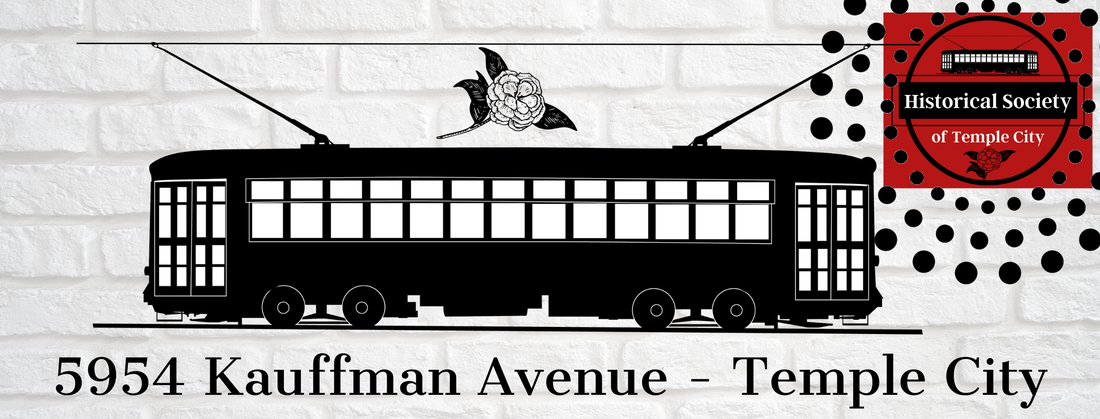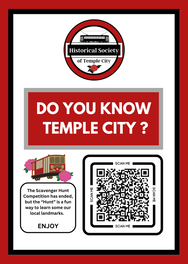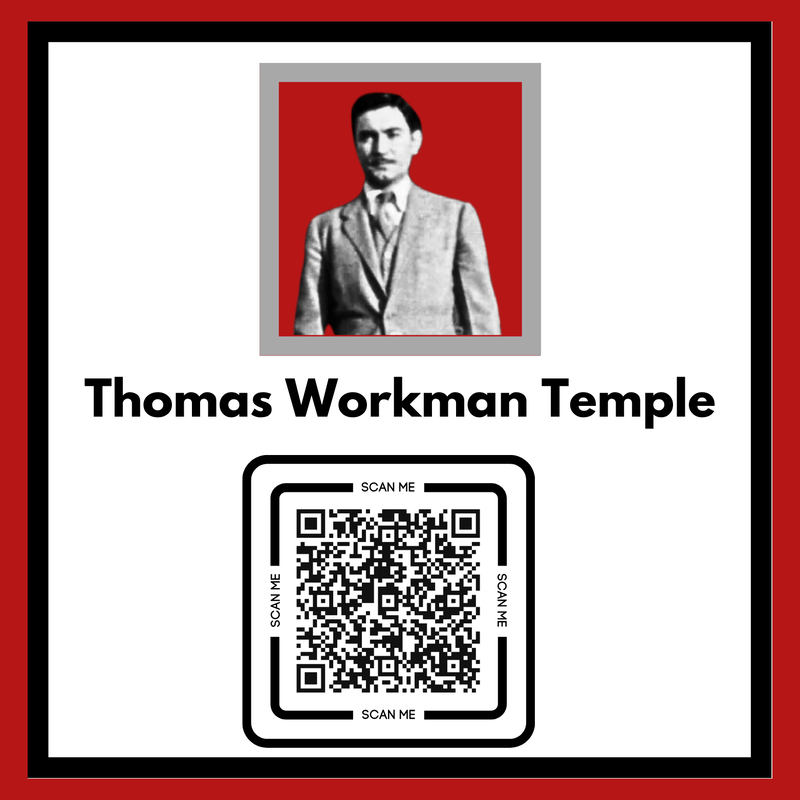.... a little information about the Historical Society In 1987 thee members of the Woman’s Club of Temple City: Julie Estrada, Shirley Norman, and Florine Thompson, petitioned the City to start the Historical Society. The City granted the request on the basis that it would be a separate non-profit organization. Loui Merritt was the first President of the Historical Society; he also served as Mayor and Councilmember, in addition to being a very popular locksmith. Due to the generosity of the City the old media building at Live Oak Park was loaned to the Society for use in 1980 to establish a public museum. The late Sig Caswell loaned/gifted many artifacts of historical interest to help with the displays. In June of 2006 the Woman’s Club of Temple City gift-deeded their building on the corner of Kauffman & Woodruff to the Historical Society to become a permanent home for the Museum and Society. The only stipulation being that the Society preserve and maintain the property. The Annual Membership for the Historical Society of Temple City is reasonable, and donations are always appreciated. Donation of artifacts to the Museum are welcome should they directly relate to the history of Temple City. General Membership Meetings General Member Meetings are customarily held four times a year. Meetings include a program of historical and/or educational value. Refreshments are served and the Museum remains open 30 minutes after the conclusion of the program.
The Historical Society of Temple City is a
|
MUSEUM The Museum has been newly remodeled and access if available by appointment only at this time.
The Museum Entrance is located at 5954 Kauffman Avenue (corner of Kauffman & Woodruff, next to LA County Fire Station #47). Admission to the Museum is free. Tours and speakers are available with advance notice. Contact the Historical Society by phone at (626) 684-8306 or send an email to ... [email protected] THE MUSEUM IS OPEN BY APPOINTMENT ONLY ------------------- THE WOMAN'S CLUB HALL IS AVAILABLE FOR USE Vitis the "Hall Use Information" Tab for details. WOMAN'S CLUB HALL The historic Woman's Club Hall may be used for various activities, including the following: meetings, business events, birthday celebrations, dance/music recitals, memorial receptions, ladies teas, fashion shows, and anniversary celebrations. Subject to availability and approval by the Board of Directors as determined by the Rental Facility Coordinator. A Rental/Facility Use Agreement must be completed prior to any event. A minimum of two weeks advance notice is appreciated. Visit the "Hall Use Information" tab for further information. |
A BRIEF HISTORY OF TEMPLE CITY
It all began when Abraham Temple arrived in Salem, Massachusetts from England in 1636. However, it was not until 1822 that a descendant by the name of Pliny Fisk Temple was born. He and an older step brother would later have great influence on our area.
Jonathan Temple (step brother) arrived in California in 1826, becoming the first merchant of Pueblo de Los Angeles, establishing a general store. He also created the first courthouse and a theatre.Temple Street in downtown Los Angeles stands in recognition of Jonathan, a highly respected man!
Pliny Temple left New England in 1841 to join Jonathan. His mother permitted him to stay in California for two years; he did not return home for thirty years! His arrival being in Monterey by sea and then by horseback to Pueblo de Los Angeles.
Pliny took a job with Jonathan in his general store. He learned Spanish and four years later was baptized at Mission San Gabriel. His godfather was Hugo Reid, owner of Rancho Santa Anita. Mr. Reid gave him his added name “Francisco” becoming Francisco Pliny Fisk Temple. He later married the daughter of William Workman, Antonia Margarita Workman. Mr. Workman was a trader coming from Santa Fe, New Mexico, with his partner John Rowland. Both of these families were granted acreage surrounding the present-day Mission San Gabriel.
In 1850 Pliny acquired co-ownership (through marriage) of Rancho La Merced.Here he settled raising his family, cattle, and crops of peaches, apricots, olives, figs and other fruits on 2300 acres. One of Pliny and Antonia’s eleven children, Walter P. Temple was born in 1869; he would later become the founder of the Town of Temple which would later become known as Temple City.
In the 1870’s, after many years of drought conditions Pliny lost most of his assets. Jonathan also faced financial failure during this time. They negotiated a loan from the famed Elias “Lucky” Baldwin, but later lost it all through forfeiture to Baldwin.
In 1903 Walter P. Temple married Laurenza Gonzalez. The couple had four children, one of whom Thomas II, would later supply money to his father to fulfill his dream of establishing a middle-class community. Thomas discovered oil in the La Merced Hills (now the area of the City of Montebello), thus enabling the repurchase of the land from Lucky Baldwin. Walter was able to realize his dream in 1923, in the establishment of the Town of Temple. This was a town where people of medium income could come to afford a home and build a life for themselves and their family.
In 1924 the town further blossomed after Walter petitioned and received an extension of the Los Angeles to Alhambra line of the Pacific Electric Railway Co., known at the Big Red Card. The name of the town was changed in 1930 to Temple City, and incorporated in 1960.Unfortunately, in the early 1940’s the Pacific Electric Railway discontinued the route to Temple City.
Jonathan Temple (step brother) arrived in California in 1826, becoming the first merchant of Pueblo de Los Angeles, establishing a general store. He also created the first courthouse and a theatre.Temple Street in downtown Los Angeles stands in recognition of Jonathan, a highly respected man!
Pliny Temple left New England in 1841 to join Jonathan. His mother permitted him to stay in California for two years; he did not return home for thirty years! His arrival being in Monterey by sea and then by horseback to Pueblo de Los Angeles.
Pliny took a job with Jonathan in his general store. He learned Spanish and four years later was baptized at Mission San Gabriel. His godfather was Hugo Reid, owner of Rancho Santa Anita. Mr. Reid gave him his added name “Francisco” becoming Francisco Pliny Fisk Temple. He later married the daughter of William Workman, Antonia Margarita Workman. Mr. Workman was a trader coming from Santa Fe, New Mexico, with his partner John Rowland. Both of these families were granted acreage surrounding the present-day Mission San Gabriel.
In 1850 Pliny acquired co-ownership (through marriage) of Rancho La Merced.Here he settled raising his family, cattle, and crops of peaches, apricots, olives, figs and other fruits on 2300 acres. One of Pliny and Antonia’s eleven children, Walter P. Temple was born in 1869; he would later become the founder of the Town of Temple which would later become known as Temple City.
In the 1870’s, after many years of drought conditions Pliny lost most of his assets. Jonathan also faced financial failure during this time. They negotiated a loan from the famed Elias “Lucky” Baldwin, but later lost it all through forfeiture to Baldwin.
In 1903 Walter P. Temple married Laurenza Gonzalez. The couple had four children, one of whom Thomas II, would later supply money to his father to fulfill his dream of establishing a middle-class community. Thomas discovered oil in the La Merced Hills (now the area of the City of Montebello), thus enabling the repurchase of the land from Lucky Baldwin. Walter was able to realize his dream in 1923, in the establishment of the Town of Temple. This was a town where people of medium income could come to afford a home and build a life for themselves and their family.
In 1924 the town further blossomed after Walter petitioned and received an extension of the Los Angeles to Alhambra line of the Pacific Electric Railway Co., known at the Big Red Card. The name of the town was changed in 1930 to Temple City, and incorporated in 1960.Unfortunately, in the early 1940’s the Pacific Electric Railway discontinued the route to Temple City.










